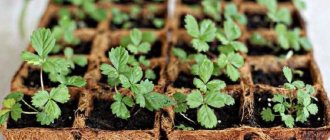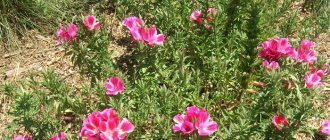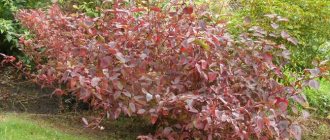If you are just going to plant strawberries or can’t achieve a good harvest, or are looking for the ideal variety, or just want to know everything about growing this crop, read the material from experienced breeder Mikhail Kachalkin.
He comprehensively answered all the questions that arise for both beginners and experienced gardeners in the process of selecting, planting and caring for garden strawberries. He also shared his secrets and proven varieties.
Mikhail Kachalkin – Candidate of Agricultural Sciences, breeder, director of the Experimental Breeding Nursery LLC.
How to choose the size of a strawberry bed
At your discretion. But practice shows that a width of 90 cm is convenient for all work on caring for strawberries. How many bushes do you need? If you just eat, then 15-20 plants are enough for a family of three. For each plant, allocate approximately 0.5 sq.m. in the garden bed.
And if there are a lot of berry lovers, and even preparations are planned, then you probably need 50-60 plants. Focus on a yield of 0.5 kg per bush. Moreover, using the earliest and latest varieties, you can stretch the supply of fresh berries for 30-40 days, from the end of June to the beginning of August. And in the case of remontant varieties - from early June to mid-October. But keep in mind that a planting pattern of 50x50 cm is too small, 60x60 cm is better, so that there is good lighting and ventilation on all sides.
Pyramid made from old tires
In addition to the previous option, you can create a pyramid of tires for strawberries. When wondering how to build such a pyramid, you need to find several tires of different sizes in advance. Anything will do, from multi-ton trucks to small car models. Typically, the bottom tier is a tire from heavy-duty vehicles. Next come smaller diameters, which are selected based on the base.
The place where strawberries will be planted in a pyramid must be thoroughly cleaned and a hole dug. It must match the tire diameter. The top part of the tire with the largest diameter will have to be cut using an electric jigsaw. The remaining part is placed in the prepared hole. It is necessary to pour a 2 cm drainage layer at the bottom of the structure. It usually consists of a soil mixture mixed with expanded clay. The tiers are then made using similar methods.
Drawings and parameters of a pyramid for strawberries
There is no point in making a complex drawing for a slide, since it is a fairly simple design. The pyramid is made up of several boxes stacked on top of each other. If tires are used, then a drawing is not needed at all.
You don’t need a plan if you are building a two- or three-tier pyramid for strawberries.
It’s more difficult to deal with a structure that has 5-7 tiers, because it needs to be watered somehow. To ensure that water is evenly distributed over the soil, the slide is equipped in the center with a perforated pipe into which water is poured.
MOST READ FROM PARTNERS
The above scheme provides for the protection of the bottom of the pyramid with a galvanized mesh. She will not allow rodents to get out of the garden. When a pyramidal bed is installed on asphalt or in the yard on paving slabs, there is no need for reinforced mesh.
What fertilizers do strawberries need, and is it possible to do without them?
Strawberries do not like a lot of fertilizers, but they also cannot be grown without them. Or rather, it is possible, but you will need a lot of manure humus, compost or vermicompost. Moreover, it should be taken into account that many nutrient soils that are sold in garden centers contain mineral fertilizers.
So, “mineral water”, preferably imported chlorine-free water, for example, New Universal in a dose of 50-70 g per 1 sq.m. We dig everything well, select the weeds, mix the mineral water and compost with peat and form a bed 20-25 cm high. We plant the seedlings in a week or two, or preferably three, after the earth has settled a little.
Selecting a location
First of all, you need to decide on the optimal location of the beds. In this case, the agrotechnical conditions for growing strawberries are taken into account:
- False berry prefers being in the sun. It will produce a poor harvest in the shade of trees; in addition, during spraying of the crown, chemicals will fall on the strawberries.
- The plant must be protected from the wind. It is recommended to place it between currant and gooseberry plantings.
- If possible, strawberries are planted in the southeastern part of the garden plot. The area should be flat or located on a slight hill. It is important to exclude low-lying areas where water accumulates.
- High yields can be achieved on sandy and sandy-loamy soil, which is enriched with humus. Strawberries do not bear fruit well on calcareous and saline soil with a high groundwater level.
- Ideally, if parsley, radishes, corn, carrots, and any types of legumes grew on the site before. At the same time, you should refuse to plant in areas where tomatoes, cucumbers, eggplants, potatoes, and peppers were grown.
Why do many people cover their garden beds with black film?
Variety Evis Delight
We advise you to purchase a film or non-woven material of black color, with a density of 80 g/sq.m. When growing strawberries, it allows you to solve several problems at once. First of all, it is protection from weeds, which with regular watering are a real disaster. Secondly, the soil under the shelter will dry out less and warm up better, and this is very good for plants.
And finally, the berries will lie on clean material, which means they will rot less. In addition, the tendrils that form at the beginning of flowering will not be able to take root on the black tissue, and you will not have to tear them out of the ground - you will simply cut them off several times during the season: if they are not removed, they will “eat” up to 30% of the harvest.
If you want to breed a certain variety, then young rosettes can be rooted in pots, and then separated from the mother plant and grown in a greenhouse. Just keep in mind that plants in pots require daily watering.
Making a wooden pyramid
When wondering how to make a pyramid for strawberries yourself, many, looking at the drawings, remember children's sandboxes. Indeed, a do-it-yourself strawberry pyramid, the drawings of which you can draw up yourself, will resemble a children's playground, albeit in an unusual design. For manufacturing you will need the following materials:
- wooden boards of durable thickness, their dimensions are determined by the original area of the site. Before work, it is important not to forget to saturate them with drying oil. And then sand it with sandpaper and varnish it. This will help smooth the boards and reduce the risk of injury for both the berry and the gardener;
- material for fastening the tiers of the pyramid, with which the boards will be connected to each other;
- hammer with a building level;
- soil, with which after completion of the work it will be necessary to fill the pyramid.
The pyramid construction scheme begins with leveling the prepared area of soil. After the process, the manufacturing of the largest part of the structure begins. It usually requires boards about 30 cm in size. They need to be connected using fasteners, forming a square or rectangle shape. Then deepen the structure about 15 cm deep into the ground. Then you immediately need to fill the bottom layer with soil.
MOST READ FROM PARTNERS
The strawberry pyramid is first filled with nutritious compost, humus and coarse sand. Then water the structure generously and leave for half an hour for the soil to settle. Next, if necessary, you can add more soil to the bed so that it reaches the edges of the boards, but does not spill out of them.
Then you need to build the second part of the pyramid. Which, according to average estimates, should be 70 cm smaller than the first plot. Such space is optimal for comfortable germination of strawberries. The second part must be placed strictly in the center on the base of the pyramid, then the process is repeated, similar to the first stage. Then you need to install another tier according to the same principle as the first two.
When wondering how to build a pyramid for strawberries with your own hands, you can pay attention to another way to create a structure.
Caring for garden strawberries after planting
First of all, high-quality regular watering is necessary. Shading promotes survival of bushes very well. This can be old non-woven material or simply tufts of grass or hay placed on top of planted plants for 3-4 days. They will protect the seedlings from the sun and wind. If it is the beginning of May, then you can simply throw non-woven material on top of the bushes.
If you plant seedlings in mid-May or later, then a frame is already needed (as for cucumbers), because Plants may burn under non-woven material. In this form (under the frame) they can be kept until the beginning of June, watering and opening at least once a week. It is very useful to pick off the first flowers, then the plants will be well formed and will subsequently give you a bountiful harvest. Before flowering, remove the cover, because flowers must be accessible to bees.
Covering vertical strawberry beds for the winter
You can’t just leave a pyramid with seedlings over the winter. A thin layer of soil will freeze and the strawberries will die.
Before frost, the bed is covered with agrofibre and spruce branches on top.
Craftsmen build a vertical bed on wheels. Then such a structure is simply rolled into an outbuilding until spring.
Over time, the novice gardener will gain his own experience. And he will have his own methods and secrets of growing strawberries in a pyramid-bed.
Watch the video: multi-tiered strawberry bed
ACTUAL NEWS
You may also find the following materials useful:
- What to put in the hole when planting strawberries?
- Everything you need to know about watering grapes in the summer
- Why doesn't apricot bear fruit? Basic ways to solve the problem
- Formative pruning of the currant crown will provide all parts of the plant with sunlight
- Fertilizing strawberries: from bud formation to fruiting
Caring for remontant strawberries
If you planted remontant strawberries, you will have berries almost until the end of October. Therefore, in mid-August, you can again build a shelter from non-woven material, but with good end ventilation.
In addition, keep in mind that remontant strawberries are more demanding in terms of watering and fertilizing. During the season, it is enough to feed the strawberries twice: once in the spring, in early May, and then after harvesting. A complex mineral fertilizer such as Kemira Universal is suitable. If you are against mineral fertilizers, use an infusion of chicken droppings or manure, just do not overdo the concentration.
Preparatory activities
Many novice gardeners, due to inexperience, believe that it is enough to just stick a strawberry seedling into the ground.
Of course, something will grow in this case. However, to obtain a good harvest, preparation is necessary, which includes the following points:
Choosing the time to disembark. There are two options: plant either in spring or autumn. When deciding in favor of one of these two options, special attention should be paid to climatic characteristics.
Thus, spring planting is recommended if the area is characterized by cold winters with little snowfall. Otherwise, planting is usually done in the autumn. Spring planting is done quite early, in late April - early May.
The main condition is completely thawed soil. You should not rush too much, because immature seedlings may die in case of frost.
Autumn planting takes place from late July to early September. It is important to take into account the abundance of precipitation and air temperature: if there is a lack of moisture or the weather is too hot, the seedlings may not survive.
Planting seedlings into the soil too late exposes them to the danger of dying from early frosts.
Selecting a location: It is preferable to plant strawberries on a flat area rather than on a slope. Southern slopes are especially dangerous, as they can become excessively waterlogged during snowmelt.
Good lighting and eliminating the risk of flooding of land with flood waters are extremely important. In addition, the site must be protected from wind erosion. And remember that planting strawberries on the same plot for 4 years in a row significantly reduces its subsequent yield.
You should also pay attention to the type of soil. The following soils are ideal for growing strawberries: chernozem, loamy, sandy loam and dark gray forest. The preferred pH is approximately 5-6.5 and the occurrence of GW (groundwater) at a depth of about 50 cm.
Soil preparation. Before planting strawberries, the selected plot of land should be free of stones, weeds and pests. While the first two enemies can be dealt with through manual harvesting, pest control requires a different type of control.
The following method is effective: in the spring, sow the area with a green manure plant, at the end of summer, mow it and carry out additional treatment with a special compound.
Preparing seedlings. Not every seedling is suitable for planting in soil. Ideal seedlings should have a fibrous root system with a main root diameter of at least 6 mm and a length of all roots of at least 7 cm.
Also, if the roots are too long, they need to be cut to the above stated length. For planting, specimens with 4-5 leaves, white root hairs 3-4 cm long and an intact apical bud are selected.
Only after thorough preparation can you proceed to the actual cultivation of strawberries.
Wintering garden strawberries
In normal standard winters, strawberries overwinter well, including foreign varieties. But sometimes, when there is no snow for a long time in November-December and frosts down to –15-20°C, it can freeze, so be prepared to cover the plants with straw, sawdust, and non-woven material. But keep in mind that this cannot be done in advance: it may turn out that deep snow will fall on the wet soil and there will be above-zero temperatures under the shelter all winter, then the plants may be supported. If the ground is frozen and severe frosts are predicted, then you need to go to the dacha and cover the strawberries.
The simplest and most effective solution is non-woven material. In the spring, after the snow melts, it is immediately removed and the strawberry foliage crushed from the snow is loosened. In addition, it is very useful to spray old leaves with some copper-containing preparation (copper sulfate, copper oxychloride, HOM, Abiga-Pik fungicides) in the concentrations recommended for treatment of green foliage. Or simply dust the leaves with dry wood ash at the rate of 20 g per plant.
In some years, when the snow is deep, the soil beneath it thaws early, and conditions for basking plants again arise. Therefore, if this happens, do not be lazy at the end of winter to dig out the bed and leave only a small layer of snow.
Tying up
One of the easiest ways to tie strawberries in the beds and thereby protect them from excess moisture and gray rot is the process of fixing them with a rope:
- At the edges of the bed, two pegs are driven in, to a depth sufficient for them to withstand the tension of the rope;
- The rope needs to be well stretched and tied to the driven pegs;
- If the rope sag due to the length of the bed, you need to drive additional stakes in the center;
- The last step is to fix the strawberry shoots with ovaries on a rope so that the ripe berries do not touch the ground.
How to prepare a bed for strawberries will determine its productivity for several years, which is why the procedure should be approached responsibly and thoroughly.
Picking
Opinions about picking vary among gardeners. Some are against it, believing that in this way young seedlings are exposed to very strong stress. Others, on the contrary, are sure that in this way the bush forms a stronger root system.
Eggplants - growing features and care rules + 78 photosGrapes - history, description, care features, varieties and diseases + 80 photos
- Stinging nettle - medicinal properties, effects and applications + 74 photos
It is necessary to carry out the picking manipulation when the bush has up to 4 true leaves.
The most suitable method can be considered transferring it together with a lump of earth into another container for planting. You can also cover it with glass for several days to create a greenhouse effect.Disease susceptibility
Botanists and breeders are trying to develop the most resistant varieties, however, prevention is necessary, and you also need knowledge of possible diseases and pests that can spoil your strawberry beds.
The most dangerous are powdery mildew, gray mold, strawberry mite and strawberry nematode. If a strawberry bush is infected by strawberry nematode, the bush is dug up and burned. It manifests itself in damage to the leaves, which curl, and when the pest multiplies very quickly, the stems of the plant are also affected.
For strawberry mites, the number one remedy is Karbofos. The manifestation of this parasite is manifested in a change in the appearance of the leaf itself, it becomes wrinkled, and the fruits become smaller.
With powdery mildew, all leaves become covered with whitish spots, which soon acquire a grayish tint. The plant becomes very sick, its growth and development are inhibited, and the inflorescences simply fall off. Bushes with such damage can be sprayed with Bordeaux mixture.
And also one cannot help but highlight a dangerous disease that is fungal in nature - gray rot. Characteristic of this lesion is a complete modification of the bush and berries; they are all covered with a grayish coating. In order to avoid this disease, it is necessary to adhere to the rules when planting plants, not to plant bushes too close to each other, and it is also necessary, for preventive purposes, to spray the plant during its flowering with Teldor or Signum.
Kinds
A smart strawberry bed allows you to produce a bountiful harvest for a long time. Properly organized agricultural technology lasts up to 5 years. Then a change of site is required, because the soil is depleted and the bushes weaken. They arrange high, vertical and pyramidal ridges.
High
Preparing a high bed for strawberries begins in the spring. The height of the fences can be 20-40 cm or 80-100 cm.
The first option is most adapted to changes in weather conditions. The low side prevents the soil from drying out. This design is equipped with drip irrigation.
Before installing the box, remove a 10 cm layer of earth, fill it with broken bricks and branches for drainage
High beds are easy to cultivate, but are susceptible to soil drying out in hot weather and berries freezing in cold weather. The second option is recommended to be installed in damp areas where the soil does not dry out or where groundwater is high.
The height of the bed allows you to lay a good drainage layer of stones or broken bricks. After planting the plants, the soil must be mulched with hay or wood chips.
High beds must be covered with non-woven agrofibre for wintering and drip irrigation installed in the summer for uniform distribution of moisture
Vertical
A new and exotic idea for many summer residents, growing strawberries has a number of advantages and disadvantages. Advantages of the technology:
- saving space in small summer cottages;
- convenient to care for, no need to bow before the discount;
- contact with the ground is limited, the roots of the berry are less susceptible to diseases;
- eliminates thickening of plantings;
- looks decorative.
The soil substrate for vertical beds is diluted with hydrogel to reduce irrigation.
Disadvantages of the technology:
- the soil freezes quickly in winter;
- weekly feeding is required;
- In summer, the substrate dries out quickly.
When arranging a vertical bed for strawberries, the pipe size is chosen with a diameter of 10-20 cm.
To prevent the soil from drying out, install a drip tape in the center of each pipe, this allows the moisture to be evenly distributed
Pyramid
Convenient beds for strawberries are made from boards in such a way as to form a pyramid. It has a decorative function. To prevent the soil from drying out on a high ridge, each tier is equipped with drip tape for irrigation.
The substrate filled with perlite and organic fertilizers is poured into the pyramid in layers
In winter, plants are mulched with straw or hay. In the northern regions, in order to preserve the berries in winter, the structure is carefully covered with non-woven fiber.











